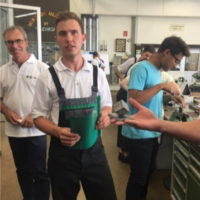Sharing and promoting the work of our regional collaboratives is extremely important. It is their hard work and effort that drives the engine that is the National Fund. Local Investment @ Work is a platform where regional collaboratives share stories about any successes, challenges, thoughts, or more about the important work they are doing locally.
Please be sure to stay up to date with all Local Investment @ Work updates by following our LinkedIn Showcase Page, as well as using #LIAW on social media.

Apprenticeship is gaining momentum as a bipartisan workforce development strategy to address employer-expressed challenges. The combination of hands-on experience, classroom training and a paycheck are enticing policymakers and workforce stakeholders to reexamine and reinvigorate their apprenticeship efforts. This is especially true in southern Virginia where the Dan River Region Collaborative, with support from the National Fund for Workforce Solutions, is building regional capacity to support expanded apprenticeship opportunities.
Timing to expand apprenticeship could not be better. Many states, including Virginia, are experiencing record low unemployment; talent is hard to come by and employers, who may have been reluctant to try apprenticeship, are feeling the pain. Furthermore, the federal government, in bipartisan fashion, is extremely supportive of apprenticeship and is poised to release additional funding, along with new-more flexible- guidelines in order to expand opportunities and increase employer engagement.
This past summer, the Dan River collaborative partnered with the National Fund and the Institute for Advanced Learning and Research to organize several fact-finding visits to learn about successful apprenticeship models. Project leaders and regional attendees had an opportunity to visit Siemens and Schaeffler facilities in Germany, thought of as the gold-standard country for apprenticeship. These “see the possible” experiences accelerate efforts to expand apprenticeship opportunities as employers and stakeholders learn first-hand of successful employer-valued outcomes from their respective peers.
According to the U.S. Department of Labor’s Office of Apprenticeship (FY2018), employers have supported a 48 percent growth in apprenticeships since 2014; however, apprentices make up only 0.2 percent of the U.S. labor force. In Germany, the number is closer to 4 percent – in fields as diverse as advanced manufacturing, IT, banking and hospitality. While apprenticeship scholars agree that the United States cannot easily replicate the Swiss and German models of apprenticeship, there is opportunity to develop new systems embracing this proven work-and-learn model. In the short-term, we must reimagine the U.S. culture and our notions of apprenticeship.
Many criticize the German model in large part because it requires tracking at a young age. At age 10, German children choose among an academic high school, a vocational track, or something in-between. Outside Germany, many consider this to be a very rigid system with little flexibility. In reality, the system presents opportunities for apprentices to switch tracks later on. German apprenticeship is embedded in their culture as part of the social good. There is a deep respect for skilled labor. Employers express that apprenticeship is a shared civic responsibility; it is an expected part of their budget and headcount.
In the United States, we have developed an aversion to tracking students at an early age, preferring choice backed by the conviction that “you can be anything you want to be.” However, perhaps we can agree that matching students to opportunity at an earlier age, based on appropriate academic and career guidance along with student interests, may be a way to expand apprenticeship and other work-based learning programs that connect students to good jobs. We’ve figured this out in athletics. Surely we can replicate the model in other skilled areas.
For regions desiring to build apprenticeship opportunities, they must also consider long-term strategies that influence a mindset shift from viewing apprenticeship as a blue-collar-only training opportunity to a culture that understands apprenticeship as college but without the debt— appropriate for a variety of skilled disciplines to include those that require a bachelor’s degree. Apprenticeship signing days for high school students and expansion of degreed apprenticeship opportunities in a variety of sectors (think healthcare, education, engineering, and IT) will create a culture where people understand that apprenticeship is for everyone and has clear benefits to employers and jobseekers.
So, how do we begin the process to embed apprenticeship into the fabric of a regional talent development strategy? In a place like southern Virginia, we must show students and young adults the expanded opportunity. Start with low-hanging fruit. The Dan River Region Collaborative is convening regional employers in manufacturing and construction to start the conversation; both sectors have well-established histories with apprenticeship and there are lots of best-practice examples out there. We are also working with school divisions to explore online career development tools and continuing our annual Career Expo event; these initiatives provide critical data to help inform stakeholders on the career interests of our students so that we can begin to match them to apprenticeship programs earlier in their high school career, perhaps even in middle school. How will your region start the process?
Dr. Julie Brown
Site Director, Dan River Region Collaborative
Director of Advanced Learning, The Institute for Advanced Learning and Research



